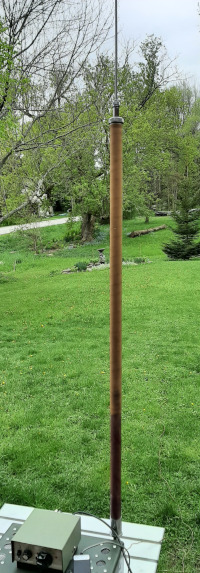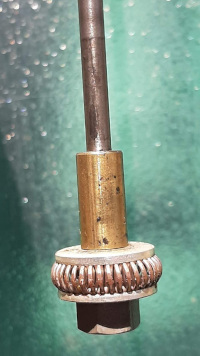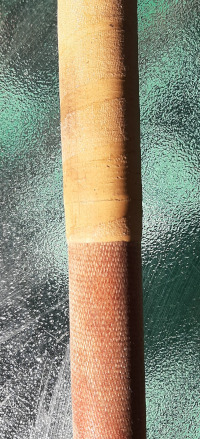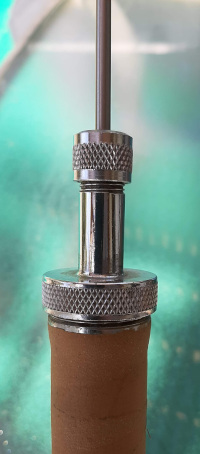Reviving a Webster Band Spanner – a 1950s manual screwdriver antenna
About 20 years ago I was approached by a neighbor who, knowing that I am a ham, asked if I might be interested in looking at some of the old ham junque he had accumulated over many years. He was a fine gentleman, in his golden years, who was no longer active in the hobby. Hesitating for less than a microsecond I eagerly agreed. Among the treasures I acquired was a Signal Electric straight key. I believe it was an R48 model first introduced in 1920 when it sold for $2.80. But my prized acquisition was a Webster Band Spanner antenna.
The Band Spanner was produced in the 1950s and 1960s by the Webster company in San Francisco. It is a center-loaded manual screwdriver antenna intended for mobile operation. Unlike modern screwdriver antennas, like the popular Tarheels, that use an electric motor to make band changes, the Band Spanner has to be manually adjusted for each band by sliding the whip up and down.
Two models were produced; the A-61 and the A-62. The A-61 (that I acquired) has an extended length of 93 inches and a collapsed length of 60 inches. The longer A-62 model has an extended length of 117 inches and a collapsed length of 63 inches. Both models support the 75-40-20-15 and 10 meter bands. There is a mark on the whip indicating the mid-point of each band. I suspect the WARC bands could also be tuned although it would be necessary to locate the correct whip length by trial and error. The antenna is rated for “100 watts or more”.
Whip connection contact Coil section (top), lower radiating section (bottom)The Band Spanner is constructed from a fiberglass support column with a 24-inch long internal loading coil. At the base of the whip is a circular contactor that connects with the windings of the loading coil. As the whip is raised or lowered, the contactor connects to individual exposed turns of the loading coil inside the support column. This type of continuous adjustment permits exact resonance to be achieved anywhere within a band. It is a very high Q antenna – moving the whip just one click up or down (one turn of the loading coil) makes a significant difference to the tuning.
Would the vibration of a vehicle change the tuning?
Whip locking screwYou might expect that a bumper-mounted antenna would be subjected to a lot of stress as a vehicle crashed through pot-holes and other rough ground, but there is a very tight connection between the whip and the loading coil. The connection is so tight that it requires some force to adjust the whip length and it is quite possible to skip a turn if too much force is used. The tight connection has a another positive benefit – it makes the connection point self-cleaning. There is also a locking thumb screw at the base of the whip to help secure it in place.
Stationary mobile operation
Bumper mountI am not a mobile HF operator; there are enough distractions already to compromise driving safety, so I prefer to use the Band Spanner as a stationary mobile antenna. For those who do intend to use it as a mobile antenna, there is the H-200 ball mount (shown in picture).
I have tried several ways of mounting the Band Spanner as a temporarily fixed position portable antenna. The manufacturer suggests using a matching section of 21 feet of RG-8/U coax and grounding the shield of the coax to the vehicle body. I did once try using such a matching section with a Band Spanner on a tripod, but it didn’t seem to improve the tuning at all. Most recently I attached my Band Spanner to my “QROp” (5-100 watts) radio set. It is a Yaesu FT-891 mounted inside a mil surplus 50-cal ammo box. The Band Spanner was connected directly to the rear of the rugged steel case. My ham-made L-match tuner was used for fine adjustment of the SWR.
Ammo can radio set with FT-891 transceiver; ham-made L-match; CWMorse extruded aluminum paddles; Bioenno 12Ah LiFePO4 battery in canvas pouch (left of picture) and Webster Band Spanner antenna attached at rear.Tuning was fairly easy. I set the radio to 20m and 5 watts power output. I threw a 17ft wire counterpoise on the ground behind the radio. A single wire counterpoise is not really sufficient ground for this antenna so additional inductance had to be added via the L-match. I would usually lay out at least 4 radials for a portable vertical antenna, but I was on a mission. I wanted to find out if the Band Spanner could be employed as the radiating element of a “POTA PERformer” type of antenna. Ham Radio Outside the Box will be exploring the “POTA PERformer” in more detail in an upcoming post. For now we can describe it as simply a raised quarter wave whip with raised tuned radials.
Now comes the surprise
Having tuned the antenna with one ground radial to less than 1.5:1 SWR I thought I was on a roll. Next step, I raised the radial so that it would not be detuned by contact with the ground. I now had the Band Spanner set for the 20m band, finely adjusted by means of the L-match to give a good SWR. I expected some further adjustment might be necessary with a raised 17ft counterpoise, so imagine my dismay when the radio flashed its “high SWR” warning.
The Band Spanner is intended to be used while mounted to a couple of tons of steel vehicle serving as its counterpoise. It is a very short, loaded vertical antenna with very high Q performance. A lesson I learned early in my ham career, but overlooked in this exercise, was that a short-loaded, high Q vertical whip requires a carefully tuned counterpoise – or a good ground. Simply using a raised 17ft wire isn’t good enough. I would have had to precisely trim the raised radial wire to get a good SWR. To make this even more complicated, a precisely trimmed radial wire counterpoise for each band would be required. So the mission objective to examine the Band Spanner’s suitability as a portable POTA PERformer was concluded. In future, the Band Spanner will be used with the best ground system I can erect during a temporary field installation.
Another thought …
A Band Spanner (or even better – a motorized screwdriver antenna) could possibly be used in an HOA situation. If it were ground mounted, with a good system of buried radials, it could potentially be disguised to prevent detection by the HOA hounds.
And finally …
I am not sure of the actual age of my Webster Band Spanner. They were produced in the 1950s and 1960s so I estimate it to be at least 60 and maybe as much as 75 years-old. The bumper mount has entirely lost its plating and is now a dull rust color. The fiberglass support column is equally dull and has lost its identifying markings. But, the antenna still functions as the Webster company intended all those years ago, which is more than can be said for its owner who is of the same vintage!
Help support HamRadioOutsidetheBox
No “tip-jar”, “buy me a coffee”, Patreon, or Amazon links here. I enjoy my hobby and I enjoy writing about it. If you would like to support this blog please follow/subscribe using the link at the bottom of my home page, or like, comment (links at the bottom of each post), repost or share links to my posts on social media. If you would like to email me directly you will find my email address on my QRZ.com page. Thank you!
The following copyright notice applies to all content on this blog.
This work is licensed under a Creative Commons Attribution-NonCommercial-NoDerivatives 4.0 International License.
#AmateurRadio #Antennas #BandSpanner #Counterpoise #Ground #OutdoorOps #Portable #POTA



